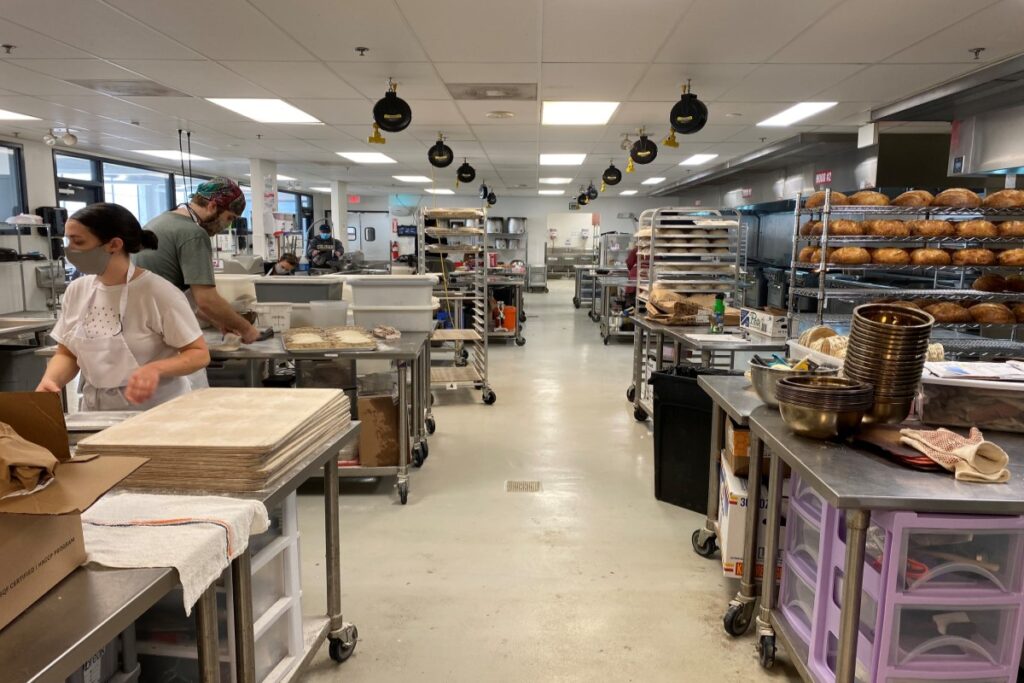
It is one of the biggest consumer trends of 2020. In the midst of a pandemic, a recession, strained supply chains and new limitations on restaurant dining, Americans turned their attention to food. In addition to juicing sales of grocery chains, big box stores and Amazon Pantry, that food fixation drove up demand for a niche commercial real estate product known as the commissary or ghost kitchen.
An offshoot of the sharing economy, these licensed commercial kitchens are rented out, often on an hourly basis, to food entrepreneurs. They function as industry-specific co-working space. Consequently, a single kitchen can support multiple food businesses.
The concept has been around for years, known as a commissary kitchen or an incubator kitchen, if it also provided business development services to new food entrepreneurs.
The pandemic, the rise of food delivery services and the rebranding of the spaces as ghost kitchens or cloud kitchens “brought a lot more attention to this industry,” said Ashley Colpaart, Founder of The Food Corridor, which supports the operations of more than 180 commissary/ghost kitchens across the United States. “Maybe it just wasn’t as sexy until it got its new moniker.”
Colpaart describes the kitchens as an effective tool of the access economy.
“In the food industry, commercial space is expensive, outfitting it with equipment is expensive, buying a walk-in freezer is expensive, utilities are expensive,” she said. “This allows someone who is just getting started in business, to access all that infrastructure without having all the overhead.”
That business edge has become especially valuable in 2020.
“In the food industry, we have seen some pretty brilliant ideas and significant innovation and pivots that have helped food businesses survive this year,” Colpaart said. “We have seen caterers pivot to delivering meals, chefs pivot to creating meal kit boxes and meal kit companies do grocery deliveries.”
Shared kitchens have enabled many food entrepreneurs to make those pivots inexpensively. They have enabled other individuals, often newly-unemployed individuals, to successfully launch food companies in the midst of the recession, she said. Ghost kitchens have also allowed established restaurants to cheaply set up satellite operations in new markets and offer delivery-only service to an entirely new clientele.
The model is also strengthening the bottom lines of existing restaurants and caterers at a time when their sales are depressed. Some of those companies have transformed themselves into commissary kitchens, leasing out their space during hours when it would normally be inactive.
When he created B-More Kitchen in Baltimore City, Jonathan Fishman designed the 10,000-square-foot facility to be a coworking space for local food businesses. Before and during the pandemic, some small or startup companies have thrived at B-More Kitchen, including bakers, producers of products that are sold at grocery stores, and food companies who have their own delivery fleet or arrange for clients to pick up orders. A Syrian restaurant uses B-More Kitchen as its production kitchen. After the pandemic began, a nonprofit began using B-More Kitchen to prepare meals for individuals facing economic challenges.
Ghost kitchens, however, are not the best fit for every food company. The model has not worked well for small restaurants looking to do delivery-only sales through large delivery services such as UberEats or Grubhub, Fishman said.
“From what we have seen and heard, the delivery services take such a big cut of the bill that they don’t work for a lot of small restaurants,” he said. “Margins in the food industry are so razor thin to begin with. You can’t give 30 percent or more to the delivery guy and still turn a profit.”
By comparison, REEF Technology successfully supports a delivery-only restaurant trade through its ghost kitchen operations at B-More Kitchen. REEF, however, is a large, national company with established delivery arrangements and access to a network of local delivery sites.
Creating a purpose-built ghost kitchen from the ground up is a significant and expensive undertaking.
“Food production is not a super easy sector to get into,” Colpaart said. “There is a lot of regulation by the local, state and federal levels so you are looking at eight to 12 months of outfitting a space before you can bring renters in.”
Operators of shared kitchens have to be meticulous not only about meeting their own ongoing licensing requirements, but also ensuring that every renter is properly licensed.
But consumer trends and economic conditions continue to drive up the demand for the kitchens and industry watchers expect that growth to continue.
After an initial drop in rentals at the outset of the pandemic, The Food Corridor saw usage of its client kitchens double from April to June as previous clients increased their production hours and new clients signed leases to start operating in those kitchens. Colpaart’s business has grown 5% monthly since April and added 11 new kitchens to its network in October.
Technomic, a research company that focuses on the food industry, recently projected that food sales from companies operating within ghost kitchens will rise 25% each year for the next five years.
“This model has taken hold and it makes a lot of sense for people,” Colpaart said. “Through this model, you can leverage under-utilized commercial kitchen capacity and give entrepreneurs access to resources they couldn’t afford otherwise. So I am extremely hopeful for this industry and its growth.”